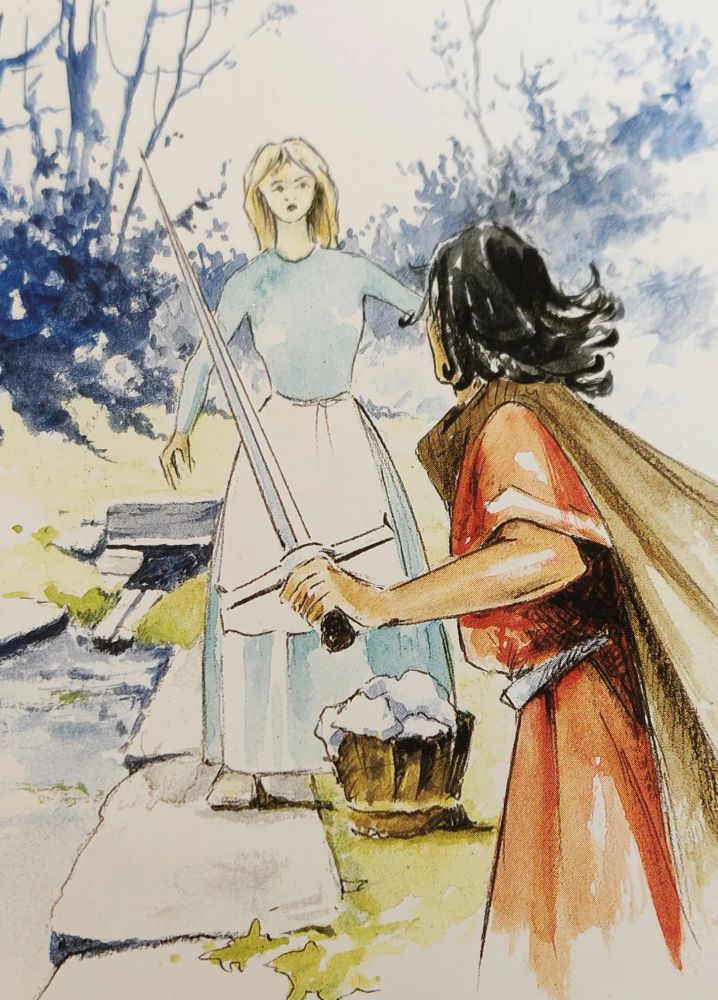Retrouvez-nous sur les réseaux sociaux
The legend dates back to the 6th century. The Lord of Trémazan had two children, Gurguy and Haude. Shortly widowed after the birth of Haude, he remarried with a cruel stepmother who roughed up the children. As a teenager, Gurguy left the castel to serve the King of France as a soldier, while Haude remained there to suffer the bad treatment of her stepmother, without ever complaining, continuing to pray and give alms.
When Gurguy returns to Trémazan, his stepmother tells him lies about the life Haude leads, forcing him to leave the castle. When he finds her, at a washing place, she turns afraid and runs away. Faced with this flight, which he takes as confirmation of what his stepmother told him, Gurguy catches her and, in a fit of violence, cuts her throat with his sword.

On his way back to the castle, Gurguy hears beggars talking about Haude’s benefits and virtues. He then understands that he was lied to and that he killed his sister for nothing: the moment he returns to the castle hall to hold his stepmother accountable, Haude appears behind him and says this sentence to him, inscribed in Breton in the Our-Lady of Graces chapel: “INTROUN VARIA AR CH’RAS”, in English “By the Virgin, I forgive you”. At the same time, the stepmother is stroke by lightning, and Haude rises in paradise.
Although he was forgiven by his sister, Gurguy decides to go and do penance with Saint-Pol de Léon. The latter sent him for forty days to the Coat-Tanguy forest. When Gurguy reappears in the front of him, he has a ring of fire behind his head: “fire”, in Breton, meaning “Tan”, then it was from that day on that he was started to be named Tanguy. The latter became a monk on the island of Batz for some time, then abbot at Gerber, current Abbey of Relec in the Monts d’Arrée.
But what is the link with the Abbey of Saint-Mathieu? It is sais that at the end of his life, Tanguy’s father decided to ced land to his son in the vicinity of Trémazan, some of which were at the tip of Penn-Ar-Bed. Impressed by the story of the Breton merchants who brought the relics of Saint-Mathieu from Ethiopia, he whould have decided to found an abbey in the honor of the apostle on the point which had opened to save from sinking the ship containing the relics.
In 2018, archeology students from the University of Quimper, under the direction of their professor Arnaud Ybert, came to Saint-Mathieu to draw a stone-by-stone plan of the interior of the north wall of the abbey (on your right when you come from the lighthouse). A true benedictine’s work ! This report teaches us a lot about how the abbey was built, and how the builders of the Middle Ages worked.
In gray on the frieze, there are coatings, in particular above the openings. Were there old doors, pierced, then blocked? The stones surrounding the plasters, in yellow, show us a rather Romanesque style, while the current, more worked openings, recall Gothic. Architectural coquetry? Need enlargement? Questions, and answers that time may allow to provide…
Alignments of stones called “fishbone” also appear, in red. Here too, we hesitate between the decorative and the functional: their inclined position could both decorate the wall and strengthen is solidity.
Finally, in blue, we can see “boulin holes”: this allowed artisans to reerve a space in the wall to embed a scaffolding, and thus consolidate or enlarge it as they wish (or as monks desired). The medieval builders were not lacking in ingenuity…
Here is a model produced by the Association of “les Amis de Saint-Mathieu” (“Friends of Saint-Mathieu” in English), representing the abbey at the height of its influence. From the outset, we notice the imposing fire tower (the “monks’ lighthouse), now halved. It also served as a bell tower in the abbey church.
We find all the usual elements of the abbeys: the cloister, the monks’ dormitory… There are also the apses chapels, behind the church, disemboweled during the construction of the lighthouse. Do not hesitate to help you with the small plan available on the model to better locate you!
Before leaving to stroll through the abbey trying to reconstruct it from these indications, have fun on this model to locate the current lighthouse and the museum in which you stand!